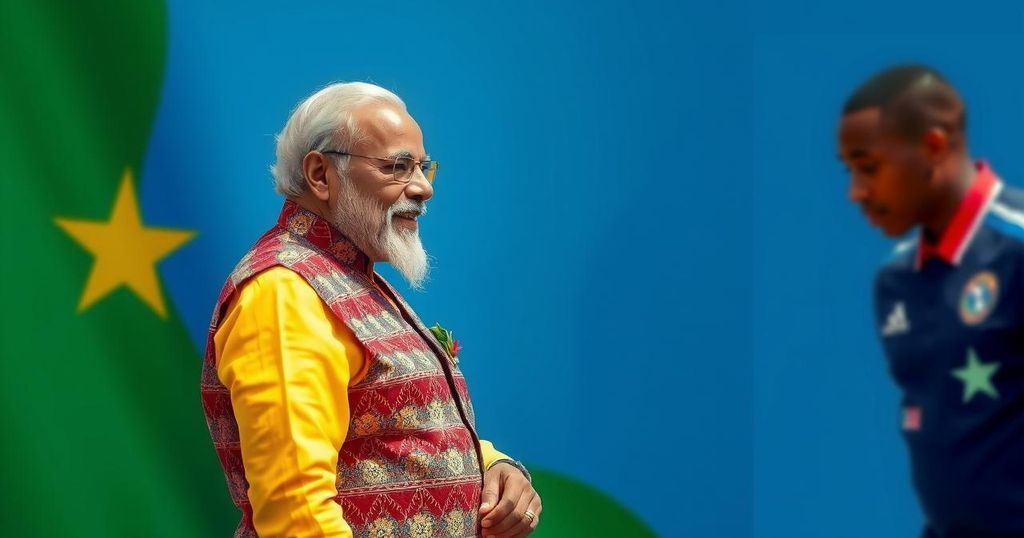India’s Strategic Engagement with Guyana: An Oil Wealth Perspective

Prime Minister Narendra Modi’s visit to Guyana is indicative of India’s strategy to strengthen ties with countries rich in resources, particularly as Guyana’s oil production is projected to surge. India’s interest lies not only in diversifying its oil imports but also in fostering broader economic relations. As Guyana seeks to enhance its global economic presence, India aims to partner across various sectors, including defense and infrastructure, amid growing competition from China in the region.
Prime Minister Narendra Modi’s recent visit to Guyana underscores India’s strategic interest in fostering ties with nations exhibiting significant economic potential and natural resources. This small Caribbean country is rapidly gaining prominence on the global stage, primarily due to its vast oil reserves, which are projected to elevate its oil production substantially in the coming years. Modi’s engagement reflects a broader objective to strengthen relationships within the Global South and diversify India’s oil sourcing amidst an evolving energy landscape. Guyana’s burgeoning oil industry, driven by recent discoveries, positions it as a critical player in non-OPEC oil production. With expectations to outpace Venezuela in oil production by 2026, Guyana’s economic growth is remarkable, boasting an unprecedented GDP growth rate that has surged to 33% in 2023, following a staggering 62% in 2022. Such growth opens avenues for Indian exports, making it an attractive market for India. Since the significant oil discoveries totaling 11 billion barrels in 2015, Guyana has experienced continuous economic growth, garnering the attention of major oil-importing nations like India. The Indian government is actively pursuing a long-term oil purchase agreement with Guyana, aiming to secure stable oil supplies through collaborations in exploration and production. Notably, the Indian Minister for Petroleum, Hardeep Singh Puri, discussed potential partnerships with Guyanese officials to enhance bilateral cooperation in this sector. India’s interest extends beyond energy. The two nations have signed a Memorandum of Understanding for cooperation in the hydrocarbon sector, encompassing crude oil sourcing, technological collaboration, and capacity development. Additionally, India is tapping into the defense market of Guyana, having provided military aircraft to the Guyana Defence Force, along with plans for future defense procurements. China’s increasing influence in Guyana due to its investments and infrastructure projects poses a challenge for India. While India is committing to develop its own infrastructure projects, including a USD 100 million road initiative in Georgetown, it remains a modest endeavor compared to China’s extensive investments in the region. The local population is reportedly concerned about Chinese investments primarily benefiting foreign workers, highlighting the need for India to present a balanced engagement strategy that incorporates local workforce development. Ultimately, India’s burgeoning relationship with Guyana marks a significant step towards a more diversified foreign policy focused on energy security, economic growth, and strategic partnerships. As Guyana’s oil wealth continues to transform its economy, India’s proactive stance could cement its presence in the Caribbean and bolster its interests in the Global South.
In recent years, Guyana has emerged as a focal point for international energy discussions, primarily due to its discovery of substantial oil reserves that have transformed its economic landscape. The country’s GDP has seen dramatic growth, reflecting its status as one of the fastest-growing economies globally. Prime Minister Modi’s visit is an acknowledgment of this shift and a strategic move to strengthen ties with nations rich in natural resources, ensuring India’s energy security by diversifying its oil supply chains. The competition with China in Guyana further emphasizes the geopolitical significance of this relationship, as both nations vie for influence in the Caribbean and seek to leverage mutual growth opportunities. Modi’s engagement presents an opportunity for India to showcase its commitment to long-term international cooperation, especially with nations from the Global South.
In conclusion, Prime Minister Modi’s visit to Guyana highlights India’s growing interest in securing energy resources and expanding its geopolitical influence in the Caribbean. As Guyana’s oil production is set to increase significantly, India aims to enhance bilateral ties not only in hydrocarbons but also in various sectors, including defense and infrastructure. The competition with China in this region adds a layer of strategic significance to India’s initiatives, emphasizing the need for a collaborative approach that supports local development while showcasing India’s commitment to fostering mutually beneficial relationships.
Original Source: m.economictimes.com







